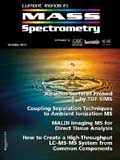Call for Papers
Spectroscopy invites researchers to submit their work for publication.
Readers interested in sharing the results of their research with more than 27,000 other spectroscopists are encouraged to submit manuscripts for review and possible publication.
Spectroscopy publishes articles dealing with practical applications of modern spectroscopic techniques and instrumentation. Contributed manuscripts commonly address any of the following topics:
- emerging techniques
- new applications of spectroscopic instrumentation
- current trends in hot research areas
- improved methods for common applications
- data-handling strategies
- solutions to sample-handling problems.
The full range of atomic, mass, and molecular spectroscopic techniques is suitable for coverage in Spectroscopy.
Manuscript Preparation
Manuscripts for regular issues should be approximately 3500–4500 words long, plus figures and tables as needed, including an abstract of approximately 150–200 words. Figures and tables, along with their captions, should appear at the end of the manuscript, and figures also must be sent as separate files, preferably in JPG, TIF, PNG, or XLS format.
References. Number the literature citations in the text consecutively in order of appearance and indicate them by Arabic numerals in parentheses. Number each reference separately. Group the references at the end of the manuscript in the order of their appearance in the text, not alphabetically.
Use Chemical Abstracts Service Source Index for journal abbreviations. Use the following format for references:
(1) R. Salzer and H.W. Siesler, Infrared and Raman Spectroscopic Imaging Wiley-VCH, Weinheim, 2009), pp. 90–103.
(2) P. Matousek, Appl. Spectrosc. 60, 1341 (2006).
Author Benefits
Publishing your work in Spectroscopy has many advantages.
Audience: The size of Spectroscopy's audience, with more than 27,000 readers, makes Spectroscopy the ideal vehicle for communicating information of broad significance to the spectroscopy community.
Peer Review: Contributed technical papers published in Spectroscopy have passed a thorough peer-review process. Our pool of referees includes the members of our distinguished Editorial Advisory Board and other recognized leaders in the field.
Rapid publication: Spectroscopy can generally achieve rapid publication of accepted articles. Our target is less than six months between submission and publication.
Special Supplements
A number of supplemental issues are planned for 2012, for which we also invite contributions. Manuscripts for the Raman, FT-IR, and ICP/ICP-MS supplements should be 2500–3000 words long, plus up to eight figures and tables, and should include an abstract of approximately 150–200 words.
Raman supplement, June 2012
Submission deadlines:
Abstracts: February 8, 2012
Manuscripts: March 8, 2012
FT-IR supplement, August 2012
Submission deadlines:
Abstracts: April 8, 2012
Manuscripts: May 8, 2012
ICP & ICP–MS supplement, November 2012
Submission deadlines:
Abstracts: July 8, 2012
Manuscripts: August 8, 2012
Current Trends in Mass Spectrometry supplement series
Our supplement series on mass spectrometry will continue in 2012 with four issues, in March, May, July, and October. Manuscripts for this series should be approximately 3500–4500 words long, including an abstract of approximately 150–200 words, plus up to eight figures and tables.
Submission Deadlines:
March 2012 issue
Abstracts: November 8, 2011
Manuscripts: December 8, 2011
May 2012 issue
Abstracts: January 8, 2012
Manuscripts: February 8, 2012
July 2012 issue
Abstracts: March 8, 2011
Manuscripts: April 8, 2011
October 2012 issue
Abstracts: May 8, 2012
Manuscripts: June 8, 2012
Contact Us
For more information about contributing to Spectroscopy, contact
Laura Bush, Editorial Director
Spectroscopy
485F Route One South, Suite 100 Iselin, NJ 08830
+1.732.346.3020
www.spectroscopyonline.com

High-Speed Laser MS for Precise, Prep-Free Environmental Particle Tracking
April 21st 2025Scientists at Oak Ridge National Laboratory have demonstrated that a fast, laser-based mass spectrometry method—LA-ICP-TOF-MS—can accurately detect and identify airborne environmental particles, including toxic metal particles like ruthenium, without the need for complex sample preparation. The work offers a breakthrough in rapid, high-resolution analysis of environmental pollutants.
The Fundamental Role of Advanced Hyphenated Techniques in Lithium-Ion Battery Research
December 4th 2024Spectroscopy spoke with Uwe Karst, a full professor at the University of Münster in the Institute of Inorganic and Analytical Chemistry, to discuss his research on hyphenated analytical techniques in battery research.
Mass Spectrometry for Forensic Analysis: An Interview with Glen Jackson
November 27th 2024As part of “The Future of Forensic Analysis” content series, Spectroscopy sat down with Glen P. Jackson of West Virginia University to talk about the historical development of mass spectrometry in forensic analysis.
Detecting Cancer Biomarkers in Canines: An Interview with Landulfo Silveira Jr.
November 5th 2024Spectroscopy sat down with Landulfo Silveira Jr. of Universidade Anhembi Morumbi-UAM and Center for Innovation, Technology and Education-CITÉ (São Paulo, Brazil) to talk about his team’s latest research using Raman spectroscopy to detect biomarkers of cancer in canine sera.